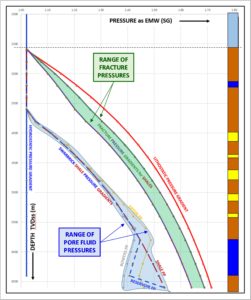16th January 2018
Event phone: 020 7408 2000
Abstract
Pressure Prediction: Geological assessments defining the drilling window
Richard Swarbrick
Pressure prediction is one of the critical elements for successful completion of a deep borehole, and a required component in well planning. Geology plays a key role in providing the context for rock and fluid stresses which define the drilling window based on pore fluid and fracture pressures. Well design involves navigating that window via setting casing at appropriate depths and selection of mudweight to prevent influx and/or losses down to target depth.
This technical mastery class is structured around three categories of activity: (a) geological context; (b) appropriate data for estimating pre-drill pressures, and (c) uncertainty linked to validation and/or calibration of predictions.
The geological context includes tectonic environment (influencing rock stresses, for example, and character of faults – flow pathway or flow barrier?), depositional environment (expected rock-types and their properties; reservoir vs non-reservoir) and burial history, which influences vertical stress history, a dominant force in developing overpressure in the subsurface.
Identifying shales, and especially shale porosity trends, plays a big part in defining expected pore fluid pressures at new well locations. Remote locations (frontier exploration) rely heavily on seismic data to quantify both pore fluid and fracture pressures. Where relevant logged intervals from offset wells provide highly valued opportunities to define expected pore fluid pressure regime. Data quality needs assessing, as well as the suitability of the methods where rocks have experienced diagenetic change, and/or uplift. Leak-Off test data provide key data for assessing borehole fracture pressures, along with fracture pressure algorithms, especially where pore pressure-fracture pressure coupling is incorporated.
Finally, validation of the pressure predictions involves assessing uncertainty, with all possible approaches taken to narrow uncertainty, including comparison with appropriate analogues. Clear communication of results from a geoscience perspective (dealing with pressure relationships) to operations/drilling (dealing with pressure in equivalent mudweight) completes the process, followed by continued interaction through the drilling of the well.
Please note lunch is not included in the cost of registration, however refreshments will be provided: mid-morning and mid-afternoon tea, coffee and biscuits.

Timings
Arrival 8.45am
Course starts 9.00am
Morning break 10.30am
Lunch (not provided) 12.30pm
Afternoon break 15.00
Close 17.00
Venue Information
Venue information
Venue name:
PESGB Croydon Office

